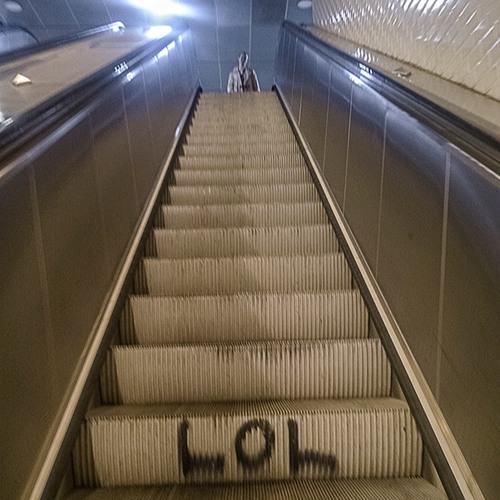Review: Lolina – Live In Paris

A figure walking at night down a street covered in snow, a sudden cut to a view from a moving train, one punctuated by pylons and greenery. Another cut to an early evening street scene of concrete, Autumn trees, a brief scan of a nearby religious building and finally a close up of a vandalized huddle of statues, their faces smeared with red paint.
Initially this footage takes on the inconsequential snapshot quality of the videos that are always earmarked for removal, the rough cut rejects resigned to deletion for the purpose of freeing up some data. Yet here it’s the anti-smartphone overture to Inga Copeland’s Live In Paris, an ersatz interpretation of the ‘live album’ drawn from a performance at Sonic A/Vantgarde, an event held by Red Bull Music Academy at La Gaîté lyrique in October. Continuing her work under the LOLINA guise – a persona first assumed on last year’s RELAXIN’ with Lolina – Copeland forgoes the formal notions usually associated with a live album when enshrined as a (quasi) legitimate release. In lieu of the ceremonial grandeur, familiar renditions and obligatory interjections of audience adulation, Live In Paris offers an evasive, vexatious, contrarian spectacle that flouts live show triumphalism for digressive, provocative, ambiguity.
First released on a freely shared Vimeo link, Live In Paris maintains the off-the-cuff non-strategies of her work with Hype Williams, as well as those of her former collaborator Dean Blunt. In both cases there’s been just as much CDRs, cassettes, limited pressings and vinyl releases as there has been mp3s and zip files slyly slipping out into the ether with very little fanfare. As for the substance contained therein, the ‘product’ of HW seemed to arise out of a hermetically sealed fug of catatonia and half-baked sublimity. Blunt on the other hand has since vacillated between an anguished loner sampling The Pastels and Pentagram for disarmingly authentic post-breakup balladry to a bellicose emcee and Babyfather (crew) pack leader, recently lacing his own rudimental versions of grime freestyles with scathing rains of white noise. Yet this has all been done with varying levels of sincerity. Copeland feels just as difficult to precisely decode as HW and Blunt have proved. Nevertheless, with 2014’s Because I’m Worth It and this secondary output as LOLINA, Copeland has moved well and truly into her own terrain. Perhaps that’s why she’s a welcome proposition to return to, not out of a deliberated air of obliqueness but out of a genuine propensity for something enigmatic and shrouded (‘I Am Your Ambient Wife’), at times peculiarly anthemic (best realised on 2014 standout ‘advice to young girls’) and entirely her own, a singularity that makes Live In Paris captivating even when it ventures into an aggravating listening experience (‘Last Days of Being A Wanker’).
Although Live In Paris has arrived as a standalone audio release the footage provided by Copeland herself, Johanna Ulfsak, Dan Mitchell, Merlin Carpenter and Xavier Gautier is worth commenting on, as it serves Copeland’s music and her LOLINA projection in interesting ways. Its sketchy quality – a range of aspect ratios, rapid movement, blurry depictions – is rooted in the moment; a walk down the street, before the entrance of a metro, a journey on an airport shuttle, a backseat view from a car. As major commercial audiovisual releases reach for Herculean melodrama, in lavish trailers possessing the anaesthetized veneer of corporate advertising, in profound concepts and ambitious narrative arcs, and in deliberated rollouts that try to make hype a virtue, there’s a sense that this aesthetic, or lack thereof, recoups some grounded sense of (sur)reality in artistry and performance, a messy verisimilitude that in some small way captures the view from behind the curtain (incidentally, the artwork is of various holdalls of backstage equipment) adding a curiously skewed prosaic dimension to Copeland’s taciturn persona and stage presence. It’s a ‘live show’ of slippery conveyance as witnessed by the unsanctioned documentarian.
Lolina – Live in Paris from Lolina on Vimeo.
From the crude handheld POV framing of those first opening shots we’re taken to a title sequence which disrupts the futurist dancehall of ‘Lolina – In Concert’ with a farcical schoolyard chant that repeats the title like a lame mantra for a fanatical but diminutive group of fans, before comically tailing off. An audience is shown accompanied by the sampled sounds of uproarious applause that begins ‘Time In EU’, a non-diegetic reception eventually manipulated into a poltergeist shriek of noise. A clock strikes with the magnitude and tone of Big Ben before offkey scales of organ grinder tones clumsily unfurl. It doesn’t sound like ‘Time In EU’ is being reflected upon favourably; a maladroit plod appropriate and timely considering the ongoing EU referendum circus. Notions of abstrusely political critique aside, this passage seems like another instance in which Copeland is playfully subverting the tropes of the live album for reasons which remain open to interpretation but become more conducive to speculation as Live In Paris progresses.
With this rough shod footage interspersed throughout, the visuals of Dan Mitchell – displayed on the 360 degree display at Copeland’s appearance in Paris – become equally cogent. A game of Monopoly that goes incrementally off the rails, it discloses a pointed critique of the London property market with red and green houses swarming the board and a pixelated fire graphic eventually engulfing everything to the sentient horror of ‘the boot’ piece followed throughout; a Monopoly staple eventually sent into a manic spin as if reeling from the ludicrous avarice on show. It’s interesting to consider Copeland in the middle of all this. It’s as if the staging reflects her perception of these events, one that becomes reduced to confusion and abstraction. Incomprehensibly obscene sums of money exchanging hands, place names becoming predicated on capital and investment, only ever visited briefly, strayed into, never really lived in. Much of the discussion around this album has centred in on Copeland’s Estonian nationality and consequently her status as an outsider. Yet Live In Paris could just as well be a playful but critical reflection of the reality for any number of people of varying descent who feel similarly excluded by London’s current socioeconomic climate.
On ‘Chance’ Copeland reels off the customary place names and impasses found on a Monopoly board with matter-of-fact detachment. And on ‘Rage’ she threads sounds of traffic jam aggravation into awkward twitches of detuned squeaking strings and bizarrely rendered grime rudiments. ‘Last Days of Being A Wanker’ – an epithet for English downfall if ever there was one – goes even further in its blundering incoherence, the sound of something endlessly stammering, jammed and trapped in a circuitous overload which never ends. This is the point at which Copeland’s sense of play edges dangerously into indulgence.
Fortunately, ‘Wheel Up My Tune!’ reasserts some clarity in the final half but only spuriously, another inimitable flip of uptempo grime before the glassy slightness of a live version of ‘I Am Your Ambient Wife’ along with the sedated organic bass dread and atonal piano mazes of ‘2nd Chance’, ‘The Logic’ and ‘Relaxx’ return to stranger, unsettling territories.
As with the playground logic, Monopoly board concept and often sketchy visual aesthetic that defines Live In Paris, these territories situate Copeland’s latest effort as a game, one that often sounds like artful Child’s play. But underneath the surface of these elements and their surreal innocence there are serious questions posed concerning identity and the realities of London life (read: strife). By incorporating instability and an unofficial feel into an album which – in its title at least – promises a ‘show’ but delivers a critique, Copeland not only gives her addressal potency but also deconstructs and subverts a parallel mainstream world that has recently attempted to co-opt multi-disciplinary approaches and notions of ‘high’ contemporary art; frequently for style over substance, for vain glorification over actually saying anything. On Live In Paris, Copeland disguises resistance with mischief but says much, much more.






















